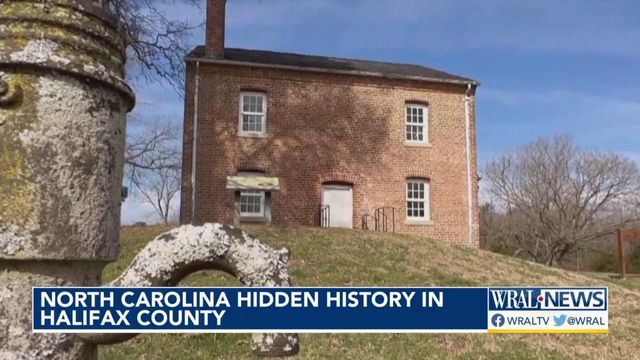Underground Railroad: 200-year-old jail marks spot of tragic endings for some Freedom Seekers
There are very few tangible remnants of the Underground Railroad left in North Carolina – but there is a place in Halifax where you can physically touch this incredible history.
This small, but historic town is home to one of the most well-traveled Freedom Roads in the state: The Roanoke River. Seeing this water meant freedom could be very near.
However, less than a mile away is another reminder of the Underground Railroad – a place where the struggle for freedom sometimes ended tragically.
“Our 1838 jail is a place, where when Freedom Seekers were apprehended, it’s one of the places they would have been brought to," says Frank McMahon, Assistant Site Manager at Historic Halifax State Historic Site

If caught, Freedom Seekers could face extreme punishment, including torture, flogging, and of course: Being sent back to slavery.
Many Freedom Seekers’ stories have been lost to time. However, ‘runaway ads’ from the era paint a picture of what these men and women would have faced.

"When we look back into the newspapers of the 18th and 19th century, we find what are called ‘runaway ads.’ When a Freedom Seeker disappeared, the slave-holders would put out an ad called a runaway ad. As researchers sometimes that’s our only real reference to these people and their search for freedom.”
However, McMahon says there is a glimmer of hope: The ads reveal that even after being captured, many Freedom Seekers didn’t give up their journey. They escaped again.
“Many of these people returned to being enslaved, but many of these people continued to seek freedom. We see that’s evident in the runaway ads – where we’ll see people who repeatedly kept on trying to seek their freedom.”

In Halifax, freedom meant reaching the Roanoke River.
“We have accounts of individuals who actually traveled through Halifax in search of freedom. One of those famous is James Williams, who actually swam across the Roanoke River near Halifax in the middle of a thunder and lightning storm.”
Today, visitors can step into a 200-year-old jail cell – and walk the Underground Railroad trail through the woods to an overlook of the Roanoke River – taking in two perspectives on how a Freedom Seeker’s journey may end.
You can visit Historic Halifax for a tangible history of the Underground Railroad. On April 12, the historic site is celebrating the 247th anniversary of the adoption of the Halifax Resolves, which was the first official action by an entire colony recommending independence from Great Britain.
Podcast: Stories about tangible remnants of the Underground Railroad in NC
WRAL's Hidden Historian Heather Leah is a seventh-generation North Carolinian with a passion for preserving the state's culture and history. Listen as WRAL's Amanda Lamb and Heather Leah share more in-depth stories from Historic Halifax and the Underground Railroad our latest podcast.
More stories about the Underground Railroad in North Carolina
In our Following the Underground Railroad series, we show you multiple places across the state you can visit to touch tangible remnants of the Underground Railroad.
Take a look at one of the last remaining relics from the Underground Railroad in NC: A genuine false-bottom wagon where enslaved Freedom Seekers once hid while trying to escape north.
Or visit a 200-year-old aqueduct, built using enslaved labor, that ended up helping enslaved men and women escape instead.
Explore this patch of old-growth woods, undeveloped since the 1800s, where the Underground Railroad Tree stands as a reminder of Freedom Seekers who once hid in these woods, helped by nearby Quakers.
Learn about the secret codes used by abolitionists to help pass messages safely in the Underground Railroad.















